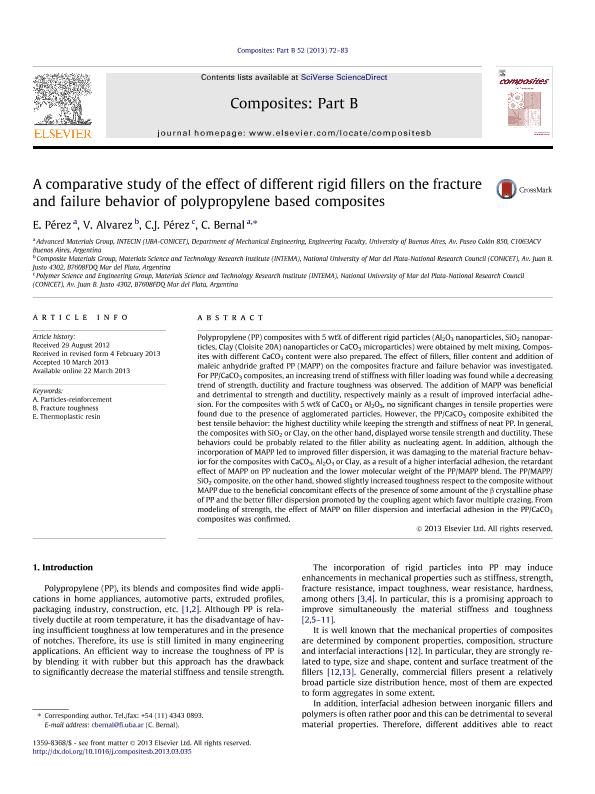Artículo
A comparative study of the effect of different rigid fillers on the fracture and failure behavior of polypropylene based composites
Fecha de publicación:
22/03/2013
Editorial:
Elsevier
Revista:
Composites Part B: Engineering
ISSN:
1359-8368
Idioma:
Inglés
Tipo de recurso:
Artículo publicado
Clasificación temática:
Resumen
Polypropylene (PP) composites with 5 wt% of different rigid particles (Al2O3 nanoparticles, SiO2 nanoparticles, Clay (Cloisite 20A) nanoparticles or CaCO3 microparticles) were obtained by melt mixing. Composites with different CaCO3 content were also prepared. The effect of fillers, filler content and addition of maleic anhydride grafted PP (MAPP) on the composites fracture and failure behavior was investigated. For PP/CaCO3 composites, an increasing trend of stiffness with filler loading was found while a decreasing trend of strength, ductility and fracture toughness was observed. The addition of MAPP was beneficial and detrimental to strength and ductility, respectively mainly as a result of improved interfacial adhesion. For the composites with 5 wt% of CaCO3 or Al2O3, no significant changes in tensile properties were found due to the presence of agglomerated particles. However, the PP/CaCO3 composite exhibited the best tensile behavior: the highest ductility while keeping the strength and stiffness of neat PP. In general, the composites with SiO2 or Clay, on the other hand, displayed worse tensile strength and ductility. These behaviors could be probably related to the filler ability as nucleating agent. In addition, although the incorporation of MAPP led to improved filler dispersion, it was damaging to the material fracture behavior for the composites with CaCO3, Al2O3 or Clay, as a result of a higher interfacial adhesion, the retardant effect of MAPP on PP nucleation and the lower molecular weight of the PP/MAPP blend. The PP/MAPP/SiO2 composite, on the other hand, showed slightly increased toughness respect to the composite without MAPP due to the beneficial concomitant effects of the presence of some amount of the β crystalline phase of PP and the better filler dispersion promoted by the coupling agent which favor multiple crazing. From modeling of strength, the effect of MAPP on filler dispersion and interfacial adhesion in the PP/CaCO3 composites was confirmed.
Archivos asociados
Licencia
Identificadores
Colecciones
Articulos(CCT - MAR DEL PLATA)
Articulos de CTRO.CIENTIFICO TECNOL.CONICET - MAR DEL PLATA
Articulos de CTRO.CIENTIFICO TECNOL.CONICET - MAR DEL PLATA
Articulos(INTECIN)
Articulos de INST.D/TEC.Y CS.DE LA ING."HILARIO FERNANDEZ LONG"
Articulos de INST.D/TEC.Y CS.DE LA ING."HILARIO FERNANDEZ LONG"
Articulos(INTEMA)
Articulos de INST.DE INV.EN CIENCIA Y TECNOL.MATERIALES (I)
Articulos de INST.DE INV.EN CIENCIA Y TECNOL.MATERIALES (I)
Citación
Perez, Ezequiel Martin; Alvarez, Vera Alejandra; Pérez, Claudio Javier; Bernal, Celina Raquel; A comparative study of the effect of different rigid fillers on the fracture and failure behavior of polypropylene based composites; Elsevier; Composites Part B: Engineering; 52; 22-3-2013; 72-83
Compartir
Altmétricas




